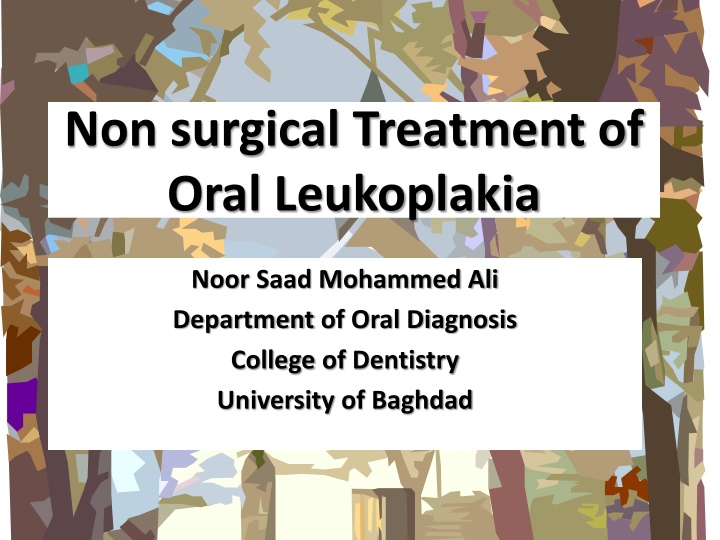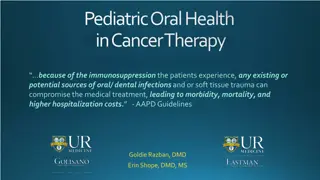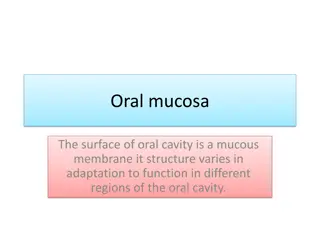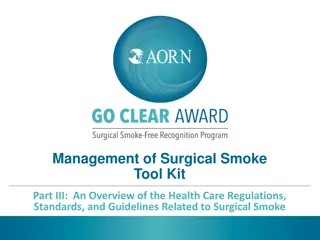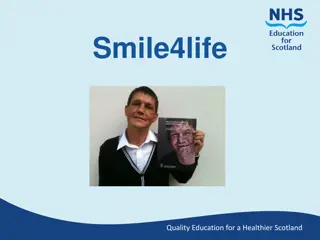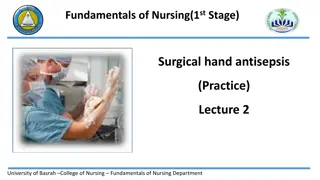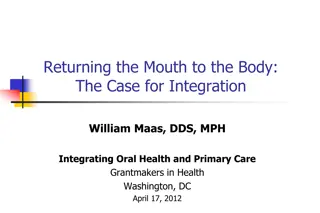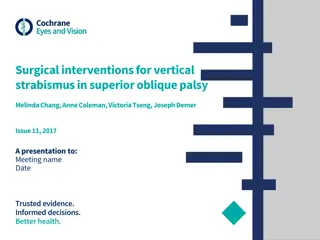Non-Surgical Treatment of Oral Leukoplakia: Insights and Management
Oral leukoplakia, a premalignant oral lesion, is explored in terms of definition, etiology, epidemiology, risk factors, and transformation rates. Learn about the non-surgical treatment options available.
Download Presentation

Please find below an Image/Link to download the presentation.
The content on the website is provided AS IS for your information and personal use only. It may not be sold, licensed, or shared on other websites without obtaining consent from the author.If you encounter any issues during the download, it is possible that the publisher has removed the file from their server.
You are allowed to download the files provided on this website for personal or commercial use, subject to the condition that they are used lawfully. All files are the property of their respective owners.
The content on the website is provided AS IS for your information and personal use only. It may not be sold, licensed, or shared on other websites without obtaining consent from the author.
E N D
Presentation Transcript
Non surgical Treatment of Oral Leukoplakia Noor Saad Mohammed Ali Department of Oral Diagnosis College of Dentistry University of Baghdad
Definition Oral leukoplakia (OL) is a premalignant lesion described as a predominant white lesion of the oral mucosa which cannot be defined as any other known lesion . the new concept of OL shall acknowledge white lesions with questionable risk of being an OL, being excluded any other pathologies or known disorders which do not present potential malignant risk such as candidiasis, lupus erythematosus, lichen planus, hairy leukoplakia, frictional keratosis, nicotinic stomatitis, and leukoedema.
Etiology OL s etiopathogenesis encompasses two broad categories, as follows: OL of unknown etiology or idiophatic and OL associated with tobacco use.
Epidemiology OL is more often found among older and elderly men, and its prevalence increases with age advancement. It has been estimated that less than 1% of the affected men are younger than 30 years old and that the prevalence increases to 8% in male patients older than 70 years old and to 2% in female patients of 70 years or more. OL s histopathological epithelium atrophy to hyperplasia, which can be associated with varying dysplasia. aspects may vary from degrees of epithelial
OL located on the floor of the mouth, soft palate, and tongue are considered as high-risk lesions, while, in other areas, they may be considered as of low malignancy risk.
OL transformation rate of 0.1% to 17%. Some factors may contribute to increase the chance of the OL becoming malignant, these include the following: has an annual malignant
(1)Gender: female patients tend to present a higher risk of developing the malignant form. (2)A long-time OL lesion: OL resistant to the treatments and what persist for long time may have worse prognosis than recent. (3)OL in sites of high risk: lesions in the floor of mouth, ventrolateral tongue and soft palate have a high risk of malignant transformation. (4)OL among nonsmokers nonsmokers with OL have an increased rate of malignant transformation in relation to OL in smokers. (idiopathic):
(5) Non homogenous OL-type: non homogenous OL lesions have a mixed color of white and red alterations, and an exophytic, papillary, or verrucous aspect; regardless of treatment, they exhibit a high recurrence rate and often eventually transformation to squamous cell carcinoma.
(6) Epithelial dysplasia: OL with moderate and severe dysplastic lesions had a significantly higher risk of developing a squamous cell carcinoma than OL without epithelial dysplasia or with mild epithelial dysplasia
Treatment In order to conduct treatment for OL, the degree of epithelial dysplasia may be assessed. In the presence of moderate or severe epithelial dysplasia, surgical treatment is recommended. However, OL presenting low to moderate malignant risk may be either completely removed or not, and the decision should consider other factors such as location, size and, in the case of smokers, the patient s engagement in smoking cessation . OL surgical treatment may be performed either through conventional surgery , electrocauterization, laser ablation or cryosurgery. Recurrence of OL after surgical treatment has been reported in 10% 35% of cases.
Nonsurgical considered for the management of OL . This modality offers minimal adverse effects to patients, especially for patients with widespread OL that involves a large area of the oral mucosa or patients with medical problems and, consequently, high surgical risks. Additionally, potential advantages of the nonsurgical treatment of OL include easy application that does not require treatment at a medical center and relative low cost. treatment may also be
1-Carotenoids 1. Beta-Carotene. 2. Lycopene
1 - Beta-Carotene The carotenoids are a group of extremely hydrophobic molecules with little or no solubility in water. Beta-carotene is a carotenoid commonly found in dark green, orange or yellowish vegetables, such as spinach, carrots, sweet potato, mango, papaya, and oranges. Beta-carotene is a vitamin (A) precursor.
The use of beta-carotene has been recommended in order to prevent OL and possibly oral cancer. The potential benefits and protective effects against cancer are possibly related to its antioxidizing action. This function is accomplished through a ligation between beta-carotene and oxygen, which is an unstable reactive molecule, thus diminishing the damaging effects of free radicals. A diet supplemented with beta- carotene can prevent changes in the oral mucosa, especially in smoker patients, who present low serum levels of vitamin C and beta- carotene when compared to nonsmokers. It has also been shown that beta-carotene has a better therapeutic clinic response in the prevention of OL lesions in smoker patients than in the nonsmoker ones.
2. Lycopene Lycopene is a carotenoid without provitamin A action. This is a fat-soluble red pigment found in some fruit and vegetables. The greatest known source of lycopene is tomatoes, which are widely employed in cooking.
There is a positive relationship between lycopene consumption and a reduction in the risk of the development of degenerative diseases caused by free radicals, such as cancer and cardiovascular diseases.
Lycopene has the uncommon feature of becoming bound to chemical species that react to oxygen, thus being the most efficient biological antioxidizing agent. Due this property, studies have been conducted with lycopene, in order to find out whether or not it could be an alternative to protect patients against the damaging effects of free radicals. In addition to its antioxidizing property, lycopene also has the capacity to modify intercellular exchange junctions, and this is considered to be an anticancer mechanism.
Nagao et al. evaluated 48 patients with OL (38 men and 10 women) and 192 control patients to verify the relationship between OL with serum levels of retinol, alpha-tocopherol, zeaxantine cryptoxantine, lycopene, and alpha and beta- carotenes. The serum levels of lycopene and beta-carotene, among the 38 men suffering from OL, were significantly lower than those of the control group Authors suggested that micronutrient levels of beta-carotene and lycopene in patients with a high frequency of smoking habit may protect against the relative risk of OL in this population. and luteine, improvement of
2-Vitamins 1-L-Ascorbic Acid (Vitamin C). L-ascorbic acid (L-AA), the so-called vitamin C, is found in citrous fruits such as kiwi, strawberries, papaya, and mango. The current US recommended daily allowance for ascorbic acid ranges between 100 120 mg/per day for adults . It has been suggested that a daily intake of at least 140 mg/day is required for smokers because they usually present a reduction of the L-AA concentration in serum .
L-AA has antioxidizing properties and reacts with superoxide produced as a result of the cells normal metabolic inactivation of superoxide inhibits the formation of nitrosamines during protein digestion and helps avoid damage to DNA and cellular proteins L-AA toxicity does not occur, since vitamin is water-soluble and a decrease in absorption efficiency occurs when consumption exceeds 180 mg/day. processes; this
In one study, 24 OL patients were treated with an association of beta-carotene, vitamin E, and L-AA, and an increase was observed in the reversion of oral mucosa dysplasia. In 97.5% of patients, dysplasia were diminished by use of antioxidant combinations. The reversion of the oral mucosa dysplastic changes was more evident in the patients using antioxidative vitamins that stopped smoking and ingestion of alcohol. There are no studies regarding the efficacy of the use of L-AA alone for OL treatment.
2--Tocoferol (Vitamin E). -Tocoferol (AT) is the commonest and most active form of vitamin E. It is found in plant oil, margarine, and green leaves. The recommended daily limit rates are 10 mg/day for adult men and 8 mg/day for adult women. Its absorption rate is reduced when consumption exceeds 30 mg/day. Tocoferol is an effective antioxidant at high levels of oxygen, protecting cellular membranes from lipidic peroxidation.
3-Retinoic Acid (Vitamin A) The current definition of retinoid includes all the natural and synthetic compounds with an activity similar to that of Vitamin A. Vitamin A exists in the human body as various interconvertible compounds, notably retinal (essential for vision) and retinol, which is the most potent analogue and the main form of storage and transportation. Retinoic acid is obtained from carotene and animal products such as meat, milk, and eggs, which, while in the intestine, are converted, respectively, into retinal and retinol.
The use of systemic retinoids is not indicated in cases of: (1) pregnancy or probability of pregnancy. (2) noncompliance with the use of contraceptives. (3) breast feeding. (4) hypersensitivity to parabeno (in isotretinoin capsules). It is, relatively, not indicated in cases of (1) leukopenia; (2) hypothyroidism (patients using bexarotene); (3) high levels of cholesterol and triglyceride; (4) hepatic malfunction; (5) renal malfunction . Absorption of systemic retinoids is boosted by up to 60% when they are taken together with the meals. Supplementation with retinoids for OL treatment began in the 1960s. However, this treatment was not widely accepted due to its side effects hypervitaminosis, teratogenic effects, and alterations in various organic systems toxicity,
13-cRA is the retinoid recommended for OL treatment. The use of 13-cRA has been shown to be effective in resolving OL. However, the high recurrence rates after discontinuance, together with its side effects, are limiting factors. Kaugars et al. supplementation in various dosages for OL treatment. Fifty percent of patients had complete or partial clinical resolution of OL, but with side effects such as dizziness and headache. Moreover, for most of the patients with clinical resolution of the lesion, OL recurred upon the discontinuance of medication. short periods of implemented retinoic
4- Fenretinide. Fenretinide (4-HPR) or N-(4- hydroxyphenyl) retinamide is a vitamin A analogue that was synthesized in the United States during the late 1960s. This retinoid shows a preferential accumulation in breast instead of liver , is effective in the inhibition of chemically induced mammary carcinoma in rats, and has proven to be less toxic than many other vitamin A analogues
A characteristic feature of 4-HPR is its ability to inhibit cell growth through the induction of apoptosis with mechanisms that may be both receptor-dependent and receptor-independent. Chemopreventive efficacy of fenretinide has been investigated in clinical trials targeted at different organs. Eight patients with diffuse oral lichen or OL were treated with 4-HPR applied topically twice daily. After one month of therapy, two patients had complete remission and the other six had a greater than 75% response. 4-HPR was well tolerated, and no local or distant side effects were observed.
3-Bleomycin Bleomycin, a cytotoxic antibiotic, was first used for the treatment of neoplasms of the penis and scrotum, but has also been employed for squamous cell carcinoma of the head and neck region, oesophagus, and skin. The most commonly adverse effects are mucocutaneous reactions, which include stomatitis, alopecia, pruritic erythema, and vesiculation of the skin.
Eight patients with OL were treated by the daily application of a 0.5% (w/v) solution of bleomycin sulphate in dimethyl sulphoxide (DMSO). After 12 to 15 applications, the white patch peeled off and the resultant raw suface was epithelialized over the following 14 days. Repeated biopsies showed a significant reduction of dysplasia and keratinisation.
4-Photodynamic Therapy Photodynamic therapy (PDT) is a noninvasive method for the treatment of premalignant lesions and head and neck cancers. The principle of PDT is a nonthermal photochemical reaction, which requires the simultaneous presence of a 1-photosensitising drug (photosensitiser), 2- oxygen, 3-and visible light. After a period to allow the photosensitiser to collect in the target tissue, the photosensitiser is activated by exposure to low- power visible light of a drug-specific wavelength.
Mainly, consists of a portable diode laser and the transmitted via laser fibres to or into the tumour. the light source light is
Illumination of the tumour by light at the activating wavelength results in the destruction of cells by a nonfree radical oxidative process. These reactive oxygen species may damage crucial cell components, such as structural proteins, enzymes, DNA, and phospholipids. PDT is a cold photochemical reaction, and the photosensitising agents are of inherently low systemic toxicity. PDT damage heals mainly by regeneration rather than scarring. Due to the organ preserving principle of PDT, important structures are maintained with good functional and cosmetic outcome.
Four photosensitisers have been approved so far: (1) photofrin has been approved in many countries for the treatment of oesophagus cancer and lung cancer. (2) 5-Aminolaevulinic acid (ALA) was also approved in several countries for the treatment of skin cancer. (3) verteporfin for the treatment of macular degeneration. (4) foscan is the only photosensitiser that has been approved for the treatment of advanced squamous cell carcinoma of the head and neck in Europe in the year 2001.
Zakrzewska etal. reported three forms of treatment of 10 cases of proliferative verrucous leukoplakia; dioxide laser; PDT. PDT was administered to 5 patients, in which there was no recurrence in 3. surgery, carbon
Results showed a recurrence rate, after treatment, of 100% for surgical excision and 85.7% for laser vaporization. PDT offered the best prognosis compared to the other forms of treatment
Conclusion Several clinical trials have investigated the treatment of OL with use of supplements. Although the administration of retinoic acid and beta-carotene has some efficacy to resolve OL, the studies were based on small samples and short periods of follow-up. Given the side effects and counterindications of antioxidizing agents, with the exception of lycopene, the use of agents requires careful control.
The small number of patients, the lack of controls, the lack of widely accepted criteria for classifying OL, the variability in nonsurgical treatment protocols, histopathologic evaluation interpretation of data of the few randomized clinical trials in nonsurgical treatment of OL. At this time, randomized controlled trials for nonsurgical treatment of OL demonstrate no evidence of effective treatment in preventing malignant transformation and recurrence. It reinforces that after clinical resolution, OL should be regularly followed. and differences difficult in the
